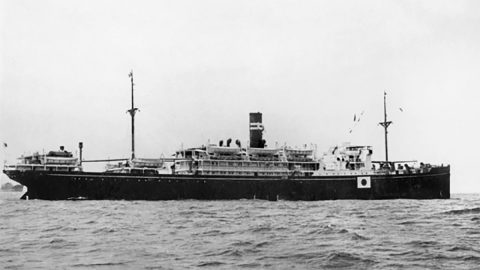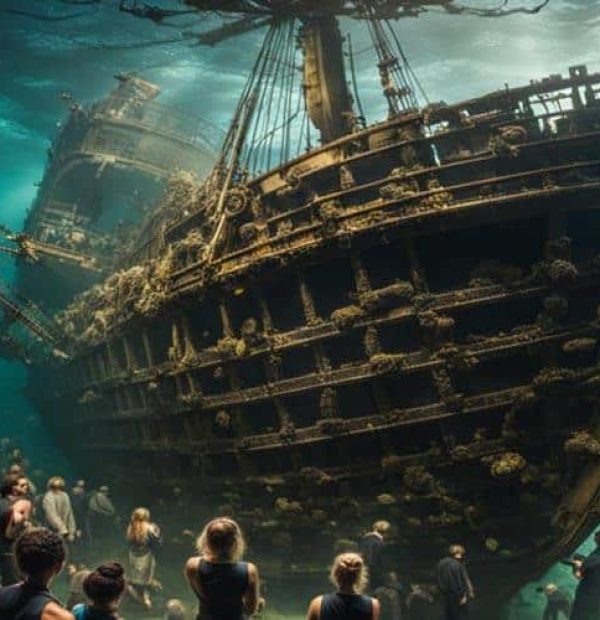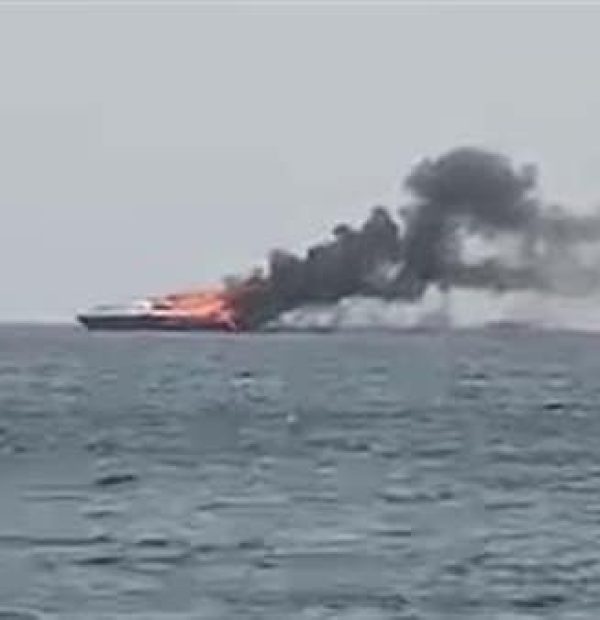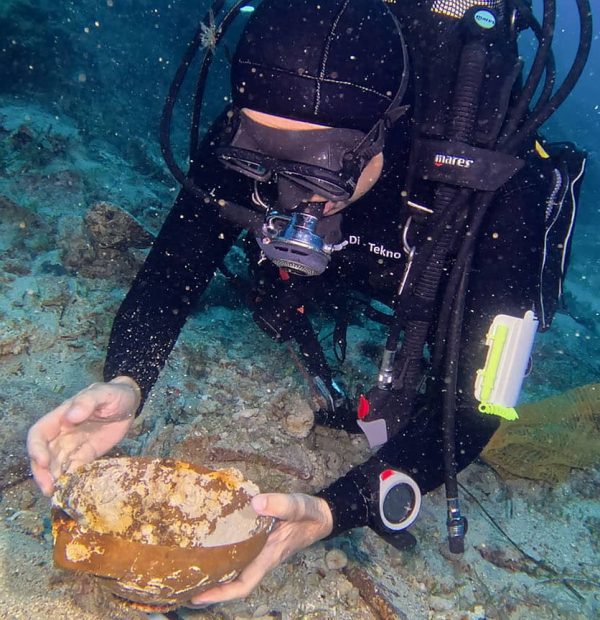Tuesday, 23 April 2024
Menu

From the translator: In English there is the term Bend or Bends, which literally means bent or bent, describing decompression sickness. The name comes from the symptoms observed in divers as a result of decompression sickness. Usually as a result of not treating the symptoms, they remained bent or creased or otherwise deformed. Other sources speak of Royal Navy divers curling up in pain on board ship. Hence the name Bend meaning bent. In our language there is no common term in diving slang for decompression sickness. As the phrase Bend appears very often in English texts, I have decided to adopt ‘Bent’ as the Polish equivalent.

It was 04:00 and I woke up with a dull ache in my left forearm and a feeling of needles being stuck in my left arm. Holy cow!
I did two dives that day, the first to a maximum depth of 44 metres with an average depth of 38 metres for 27 minutes and did 31 minutes of decompression using nitrox 50%. The second dive, the maximum depth was 26 meters with an average depth of 23 meters for 43 minutes and a minimum deco entry with a complete clean at 6 meters. Surface break was 3 hours. A trouble free two dives from a decompression point of view. The previous day (Tuesday) I didn’t dive, the day before (Monday) I only did 50 minutes at an average of 21 metres with 10 minutes on oxygen at a depth of 6 metres.
For those looking for a reason for my bending, sorry, I don’t have one and, frankly, the mechanism and cause of the bending is of no interest to me in this particular case. None of the hyperbaric doctors here in Stromness could explain it either.
This blog is more about the decision making processes that took place after awakening, I believe most divers go through the same processes and this should be discussed as it affects the effectiveness of hyperbaric treatment and there is still a ‘stigma’ attached to a DCS case and this should be changed.
So, I woke up at 04:00, thinking I should do something about it. I wondered, about the profiles of our dives. Thinking that there must have been something there. Something that the dive community would consider substandard. I didn’t care that I wouldn’t be wreck diving this week, even though it was the 100th anniversary of the sinking of the German High Seas Fleet in Scapa Flow.
After much internal monologuing, rolling over and fidgeting, I got up at 04:45 and took 600mg of Ibuprofen, thinking that maybe it would relieve the pain, which would allow me to go back to sleep and then call the chamber in the morning, 04:45 is a pretty anti-social hour for calling doctors! When I took the tablets out of the foil pack, I noticed that the sensation of the needles being inserted and the tingling was very noticeable in my thumb and fingers (except my little finger). Yes, I am not really bent….
At 05:15 I made the decision to get out of bed and get dressed. I decided to call the chamber and did so, walking to the hyperbaric chamber here in Stromness, about a 5-10 minute walk from where the boat was moored.
I called the 24-hour medical hotline and was connected to the doctor on duty, who said he would meet me at the clinic – this is about halfway between the boat and the chamber. When I arrived, we started the examination, which ended with ‘strength tests’ or endurance tests to compare my left and right hands. Three specific tests showed that there was an asymmetry between my left and right hands, and ruling out other potential factors, we decided that DCS was the most likely cause, and went to the chamber. I let Szyper know that I would not be at the dive briefing, and what was happening. However, I omitted to inform the rest of the divers, partly I think because I was embarrassed, as we had had a case of ‘undeserved’ DSC before on this trip, this time a case of the cutaneous form.
A medical team was called and I entered the chamber shortly after 07:00. I left at 11:50, was compressed and spent some time at 18m depth on oxygen and the procedures followed the standard profile in Table 6 below. I was told that the BIBS masks would be uncomfortable, this was not a problem for me as I had used similar oxygen masks many times in military aviation during my RAF flying career.
During the first and second air breaks, the assistant conducted a ‘strength’ test. During the first break there was a slight improvement over the surface test, but during the second break the improvement was very marked and it was decided that we would continue with the standard T6 instead of the extended version.
After 4 hours 45 minutes I came out of the chamber and my hand was working smoothly and there was no more needle sticking or tingling sensation.
“There are practically no human actions or decisions that cannot be made to appear flawed and unreasonable in a misleading retrospective light. It is necessary for the critic to be constantly aware of this fact” – covert quality control. Clapham Junction Hearing (Inquiry into the 1988 Clapham Junction train accident which killed 35 people)
After the event, it is much easier to connect the dots, which later seem obvious but are not visible during the events.

Lying in bed I knew something was wrong. I searched for reasons why it wasn’t a bend or a way to delay a decision. Had I slept on my left hand, which caused the needle prickling and tingling sensation? If I waited, would it go away?
The stigma associated with bending is very real, even for someone like me who knows something about it! I think taking Ibuprofen at 04:45 was a way for me to try and find something to say that wasn’t a bend, or to delay my call to the chamber, or to reduce the step from “I’m fine” to “Oh crap, I’m bent” in the same way that the PACE model provides an escalation process to improve assertiveness. (The PACE modle was initially introduced in medicine, to reduce authority differences between nurses and doctors, in order to protect assertive behaviour (PACE provides an escalation process to improve assertiveness).
I was also worried about whether anyone would criticise the profile, of my dive. A Tech 1 style dive profile (average 39m, 30 minutes) would mean about 20 minutes of decompression, but we did 31 minutes on the dive. IDeco gives 26 minutes with a GF of 20/85. In reality I had no reason to worry about this, but that’s how I perceived it.
As I said above, I didn’t bother diving in. Yes, it would cost me financially, but I know that money can be made up. I was more concerned about reputation. How can someone relatively experienced and well trained be bent? Especially someone so focused on safety!
Ironically, this has helped me. I firmly believe in ‘talking the talk’ and if there is an issue, it needs to be addressed. I have relatively thick skin, however it took me 75 minutes to make a decision!
I think something that also affected my slow decision making process was that I was alone in my cabin. Despite the fact that this week was Sunken Fleet Week, our boat had vacancies which meant that everyone had a cabin to themselves. Had someone else been in the cabin, I’m sure the decision would have been made much sooner and made by that other person!
In 1979, Daniel Kahneman and Amos Tversky published a paper on prospect theory, which eventually led to Kahneman receiving the Nobel Prize in Economics. Unfortunately, Tverksy died and the prize is not awarded posthumously.
One of the themes in this thesis is to describe the phenomenon that we prefer situations with higher levels of certainty over uncertainty, even though an uncertain situation has the potential to result in much greater losses. For example, in the case of a diver I know, losing six dives on a nine-dive trip because he was bent beforehand is definitely a small loss, relative to something really serious that could have happened to him (e.g. Tetraplegia), if he had continued diving without treatment it would have been a major loss, even if the probability is less certain. Should the diver have dived, even if he took a day off? The probability variable comes from your accessibility bias – if we don’t know about such serious negative outcomes, we don’t think they happen. Other examples include:
This tendency leads to the normalisation of deviance, where successes in the past despite departures from ‘safe’ procedures indicate success in the future, and the departures are further reinforced. The cost of the ‘now’ is the effort to return to baseline and the loss of ‘performance’ that has been achieved, compared to the loss in the future when something might go wrong. (For more on prospect theory, see Kahneman’s Thinking. Fast and Slow and Theory of perspective).
During the Facebook discussions that arose after I published my account in The Human Diver group and via private messages, I received additional information about professional divers who were bent but did not go into a chamber to heal, and even those who self-medicated with their own hyperbaric chambers. This underreporting / non-reporting is in line with previous data I collected, which showed that a large proportion of dive instructors who suffered DCS did not report to the chamber.
“All models are bad, some are useful” – George Box
The decompression models we have are only approximations. They are “close enough” because otherwise many more people would be bent. However, because they are only approximations, there are outliers and they should not be taken as the norm. Such as:
Therefore, in order to improve our trend towards greater accessibility, the industry and those in leadership positions within it need to be more proactive in highlighting that diving has many risks and that no dive is safe. Safe is a relative term because the definition of safe includes the absence of risk or harm. If the risk is acceptable (probability x outcome), then the activity is ‘safe’. Diving always has potentially negative outcomes, including DCS, and even DCS has a variable outcome! “Safe” also refers to social safety and the expectation that online couch-divers will not pick up metaphorical stones and throw them at others because they have the “full picture”, including knowing the final outcome. As many readers will already know, I am passionate about creating a ‘just culture’ of justice and a psychologically safe environment where everyone in the industry can talk about their mistakes, errors and violations without fear of social punishment.
Diving is not a sport for everyone. As such, we need to prepare divers for when things go wrong (and they will). We need to be able to anticipate, detect and catch mistakes, and when that fails, we need to be able to ‘crash’ safely. In my case there was a chamber nearby that was open, although I still felt guilty calling the doctor at 05:30 in the morning!
Questions for you, How many of you have travel/dive insurance but have no idea where the nearest chamber is when you are at the dive site? How many of you assume you can get to the chamber quickly? Just because you have insurance doesn’t mean you can teleport from your current location to the chamber!
The next time you make a decision that requires an internal monologue, when you are done, reflect on your thought process and how and why you made that particular decision. It’s all about the thinking that helps improve future decision making.
In the case of DCS, the evidence I have is that the stigma associated with declaring oneself bent is significant, and we will try to find numerous reasons to convince ourselves that we are fine, and the bent diver is often the wrong person to be involved in this decision-making process! Stigma is externally generated, which means we can do something about it by actively recognising human fallibility and the variability of human physiology.
We need to change our approach to learning and be curious rather than being judgmental and punitive. Let’s create a Just Culture and a psychologically safe environment so we can tell stories rich in context and enable learning.
Edited: Some readers have asked if this could be related to a PFO. I found out in 2009 that I had an 8mm x 12mm PFO hole, which was healed using the Amplatzer device method in February 2010. I will make an appointment with my cardiologist for another test to see if it still persists.
Gareth Lock
The original article can be found: www.thehumandiver.com
Accident analysis, decision making, cognitive errors, Gareth Lock 24 August 2019 Original title: Why ‘They should have’, ‘…could have’ or ‘I would have…’ do not improve diving safety

.
.

.










Welcome to DIVERS24.COM, your daily source of scuba news, freediving, scuba diving information, and equipment reviews. Our comprehensive coverage of the dive industry from A to Z provides you with all the latest scuba news, training updates, underwater photography tips, and everything else related to scuba diving. Whether you’re a beginner or an experienced diver looking for more knowledge about scuba gear or techniques – we’ve got it covered! With our in-depth articles written by experienced divers who have been there and done that, you are sure to find exactly what you need here at Divers24.com. Dive into scuba news today!
Underwater Media Sp. z o.o.
Szafarnia 11/F8,
80-755 Gdansk, Poland
Welcome to DIVERS24.COM, your daily source of scuba news, freediving, and scuba diving information. Sign in for a weekly news update and discount coupons for dive gear and apparel.
@2023 - underwatermedia.pl. All Right Reserved. Designed and Developed by Tworzenie stron internetowych Gdansk

The Divers24 portal is currently the largest online medium treating diving in Poland. Since 2010 we have been providing interesting and important information from Poland and around the world on all forms of diving and related activities.
Contact us: info@divers24.com